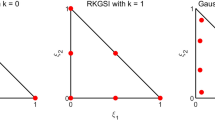Abstract
We develop and analyze a mixed finite element method for the solution of an elliptic system modeling a porous medium with large cavities, called vugs. It consists of a second-order elliptic (i.e., Darcy) equation on part of the domain coupled to a Stokes equation on the rest of the domain, and a slip boundary condition (due to Beavers–Joseph–Saffman) on the interface between them. The tangential velocity is not continuous on the interface. We consider a 2-D vuggy porous medium with many small cavities throughout its extent, so the interface is not isolated. We use a certain conforming Stokes element on rectangles, slightly modified near the interface to account for the tangential discontinuity. This gives a mixed finite element method for the entire Darcy–Stokes system with a regular sparsity pattern that is easy to implement, independent of the vug geometry, as long as it aligns with the grid. We prove optimal global first-order L 2 convergence of the velocity and pressure, as well as the velocity gradient in the Stokes domain. Numerical results verify these rates of convergence and even suggest somewhat better convergence in certain situations. Finally, we present a lower dimensional space that uses Raviart–Thomas elements in the Darcy domain and uses our new modified elements near the interface in transition to the Stokes elements.
Similar content being viewed by others
References
Arbogast, T., Brunson, D.S., Bryant, S.L., Jennings, J.W.: A preliminary computational investigation of a macro-model for vuggy porous media. In: Miller, C.T. et al. (eds.) Computational Methods in Water Resources XV. Elsevier, New York (2004)
Arbogast, T., Lehr, H.L.: Homogenization of a Darcy-Stokes system modeling vuggy porous media. Comput. Geosci. 10, 291–302 (2006)
Arbogast, T., Wheeler, M.F.: A family of rectangular mixed elements with a continuous flux for second order elliptic problems. SIAM J. Numer. Anal. 42, 1914–1931 (2005)
Arnold, D.N., Scott, L.R., Vogelius, M.: Regular inversion of the divergence operator with Dirichlet boundary conditions on a polygon. Ann. Sc. Norm. Super. Pisa Cl. Sci.-Ser. IV XV, 169–192 (1988)
Beavers, G.S., Joseph, D.D.: Boundary conditions at a naturally permeable wall. J. Fluid Mech. 30, 197–207 (1967)
Bensoussan, A., Lions, J.L., Papanicolaou, G.: Asymptotic Analysis for Periodic Structure. North-Holland, Amsterdam (1978)
Bramble, J.H., Hilbert, S.R.: Estimation of linear functionals on Sobolev spaces with applications to Fourier transforms and spline interpolation. SIAM J. Numer. Anal. 7, 112–124 (1970)
Bramble, J.H., Pasciak, J.E.: A preconditioning technique for indefinite systems resulting from mixed approximations of elliptic problems. Math. Comput. 50, 1–17 (1988)
Bramble, J.H., Pasciak, J.E., Vassilev, A.T.: Analysis of the inexact Uzawa algorithm for saddle point problems. SIAM J. Numer. Anal. 34, 1072–1092 (1997)
Brenner, S.C., Scott, L.R.: The Mathematical Theory of Finite Element Methods. Springer-Verlag, Berlin Heidelberg New York (1994)
Brezzi, F., Fortin, M.: Mixed and Hybrid Finite Element Methods. Springer, Berlin Heidelberg New York (1991)
Dupont, T., Scott, L.R.: Polynomial approximation of functions in Sobolev space. Math. Comput. 34, 441–463 (1980)
Fortin, M.: Old and new finite elements for incompressible flows. Int. J. Numer. Methods Fluids 1, 347–364 (1981)
Gartling, D.K., Hickox, C.E., Givler, R.C.: Simulation of coupled viscous and porous flow problems. Comput. Fluid Dyn. 7, 23–48 (1996)
Girault, V., Raviart, P.A.: Finite Element Methods for Navier–Stokes Equations: Theory and Algorithms. Springer-Verlag, Berlin Heidelberg New York (1986)
Hornung, U. (ed.): Homogenization and Porous Media, Interdisciplinary Applied Mathematics Series. Springer-Verlag, Berlin Heidelberg New York (1997)
Jikov, V.V., Kozlov, S.M., Oleinik, O.A.: Homogenization of Differential Operators and Integral Functions. Springer-Verlag, Berlin Heidelberg New York (1994)
Jones, I.P.: Low Reynolds number flow past a porous spherical shell. Proc. Camb. Philos. Soc. 73, 231–238 (1973)
Layton, W.J., Schieweck, F., Yotov, I.: Coupling fluid flow with porous media flow. SIAM J. Numer. Anal. 40, 2195–2218 (2003)
Raviart, R.A., Thomas, J.M.: A mixed finite element method for 2nd order elliptic problems. In: Galligani, I., Magenes, E. (eds.) Mathematical Aspects of Finite Element Methods, No. 606 in Lecture Notes in Math, pp. 292–315. Springer-Verlag, Berlin Heidelberg New York (1977)
Saffman, P.G.: On the boundary condition at the interface of a porous medium. Stud. Appl. Math. 1, 93–101 (1971)
Salinger, A.G., Aris, R., Derby, J.J.: Finite element formulations for large-scale, coupled flows in adjacent porous and open fluid domains. Int. J. Numer. Methods Fluids 18, 1185–1209 (1994)
Sanchez-Palencia, E.: Non-homogeneous Media and Vibration Theory. no. 127 in Lecture Notes in Physics. Springer-Verlag, Berlin Heidelberg New York (1980)
Scott, L.R., Zhang, S.: Finite element interpolation of nonsmooth functions satisfying boundary conditions. Math. Comput. 54, 483–493 (1990)
Author information
Authors and Affiliations
Corresponding author
Rights and permissions
About this article
Cite this article
Arbogast, T., Brunson, D.S. A computational method for approximating a Darcy–Stokes system governing a vuggy porous medium. Comput Geosci 11, 207–218 (2007). https://doi.org/10.1007/s10596-007-9043-0
Received:
Accepted:
Published:
Issue Date:
DOI: https://doi.org/10.1007/s10596-007-9043-0




